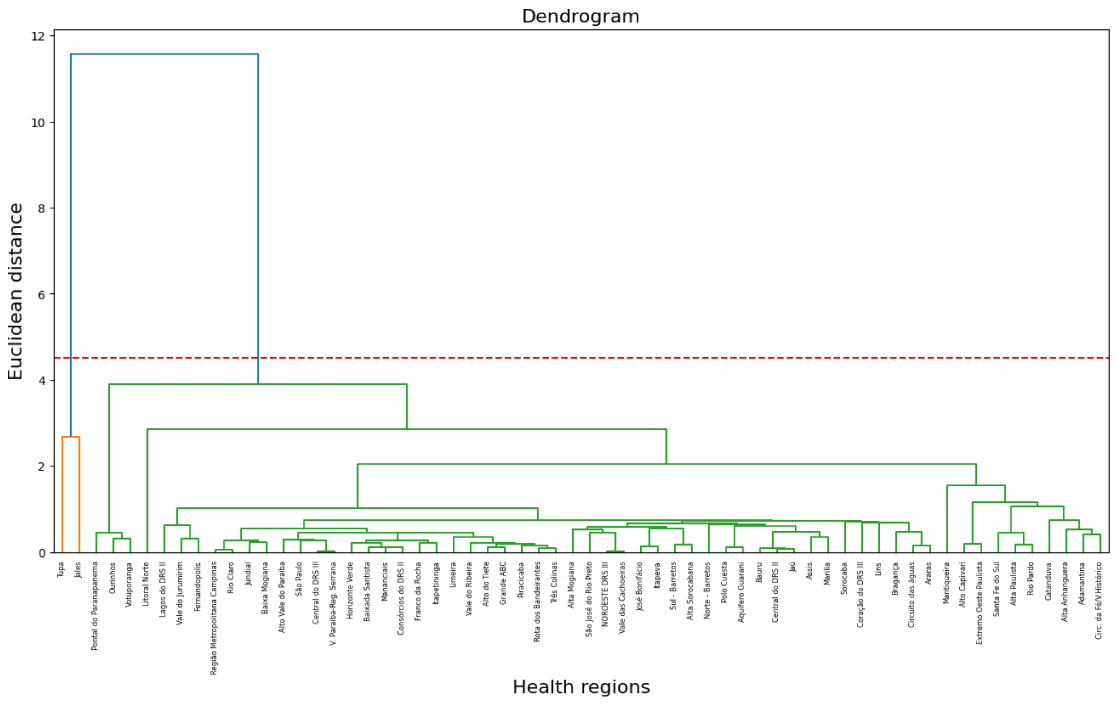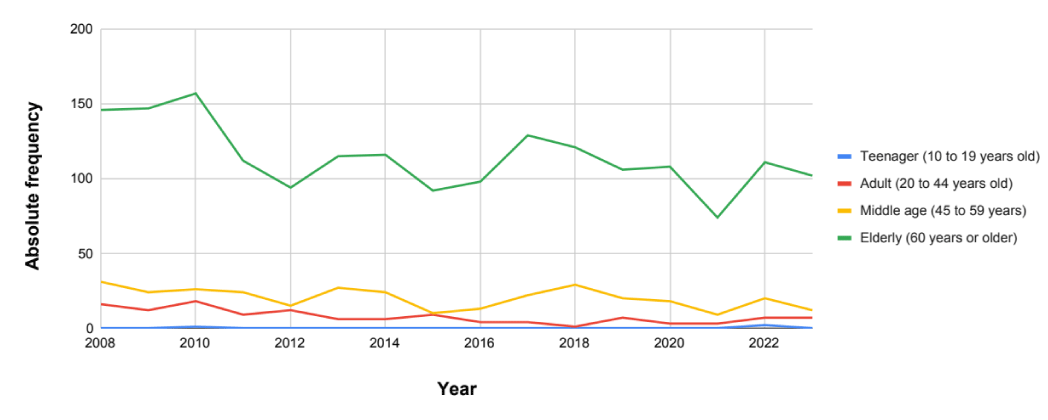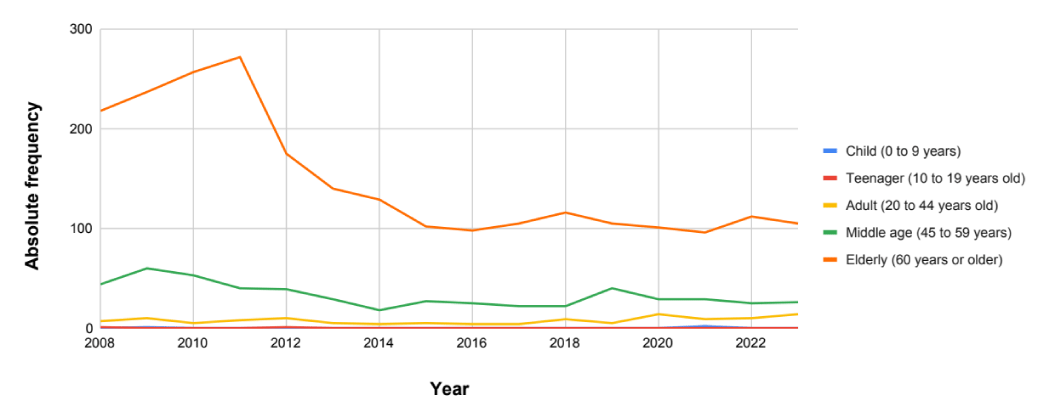Journal of Cardiovascular Medicine and Cardiology
The Impact of the Articulation of Different Health Services on Hospitalizations for Heart Failure
Alexandro das Mercês Silva*
Data Science Specialist, Specialist in Procurement, Donation and Transplantation of Organs and Tissues, University of São Paulo, Brazil
Cite this as
Mercês Silva AD. The Impact of the Articulation of Different Health Services on Hospitalizations for Heart Failure. J Cardiovasc Med Cardiol. 2025;12(4):053-060. Available from: 10.17352/2455-2976.000227Copyright License
© 2025 Mercês Silva AD. This is an open-access article distributed under the terms of the Creative Commons Attribution License, which permits unrestricted use, distribution, and reproduction in any medium, provided the original author and source are credited.Background: This study questions the influence of the typology of the health region on heart failure hospitalizations.
Methods: This is an ecological study on Hospitalizations due to Heart Failure based on the analysis of the incidence of hospitalizations and the typology of the Health Region. Ecological studies correspond to a research design that has as its unit of analysis groups of individuals (called aggregates) and not isolated individuals. In this case, the object of this study is a group of health regions and the cities that constitute these health regions. The data were then explored through cluster analysis.
Results: The Jales Health Region is made up of 16 cities, including the city of Jales, which gives its name to the health region, which accounted for 36.97% of the 522 hospitalizations for heart failure recorded in the Region in 2008. The coefficient of hospitalizations for heart failure in the Jales Region was 49.27 hospitalizations per 10,000 inhabitants of the region. The Health Region is made up of 8 cities, including the city of Tupã, which accounted for 44.33% of the total of 609 hospitalizations for heart failure in the Health Region.
Introduction
The Brazilian National Health System is one of the largest in the world, responsible for twelve million four hundred and fifty thousand seven hundred and twenty-four hospitalizations in the year 2023. Its implementation at the end of the 1990s represented a reorientation in the model of health care provision and the way in which different health services including hospital, outpatient, and primary care services.
This reorientation has been carried out through guidelines and principles that regulate the functioning of the Unified Health System, enabling the continuous improvement of mechanisms promoting inter-service coordination of different levels of complexity [1-3].
In this context, primary care provided through the Family Health Program has been the main strategy for implementing the policy of reorienting the care delivery model, by acting as one of the gateways for patients to access the health system and by acting as a coordinator for the actions of health services at different levels of care.
The importance of coordinated action between the different services derives from the impact it has on improving care and saving resources, by reducing the need for patients to access more complex levels of care and reducing the number of hospitalizations.
Based on these considerations, health systems have used indicators of hospital admissions, such as the indicator of Hospitalizations for Primary Care-Sensitive Conditions, developed with the aim of studying the financial impact of primary care on the health system, and assessing the quality and user accessibility to the service [4-9].
Hospitalizations for primary care-sensitive conditions
The Ambulatory Care Sensitive Conditions indicator was developed by Billings in the 1990s with the aim of assessing the quality and access of the population to disease prevention, diagnosis, treatment of acute diseases and monitoring of chronic diseases, by primary care.
With this same purpose, in 2008 the Brazilian Ministry of Health published the Brazilian List of Primary Care Sensitive Conditions, which makes up a total of 19 diagnostic groups, which were elected as sensitive to primary care action.
The presence of diagnoses whose hospitalizations are considered preventable, avoidable or inappropriate shows that the construction of the List of Hospitalizations for Primary Care-Sensitive Conditions did not consider the isolated work of primary care, but advocated its articulation with other levels of care, through the network work characteristic of the regionalization strategy [4,5].
Primary care and family health program
The concept of primary care is similar to that proposed by the Community Health Agents Program (PACs) implemented in 1991 in the North and Northeast regions of Brazil, whose actions focused on oral rehydration and vaccination guidance.
Considering the low coverage of medical care, community agents were gradually trained to perform functions such as: registering the population, identifying risk areas in the community and actions to prevent and promote the health of children and women [1].
Recognizing the positive results achieved by the Community Health Agents Program and the need to meet the demand for a primary care policy in Brazilian cities, in 1993 the Ministry of Health formulated the Family Health Program.
Implemented experimentally in small cities, the Family Health Program brings together a new concept in the health care model to be constituted by the multidisciplinary Family Health Team, formed by a family doctor, a nurse, one or two nursing assistants and five or six community agents.
The organization of work in the Family Health Program is conceptualized based on the approximation of the reality of the individual and community, the provision of health care aimed at the population assigned to a territory, the centrality of the family, the continuous relationship between professional and patient regardless of the presence or absence of disease, and the creation of a lifelong bond.
These elements enhance the action of the Family Health Program in addressing the social determinants of the health-disease process and in the development of intersectoral actions, characterizing it as the appropriate strategy for advancing the adoption of primary care as a policy model [1].
Regionalization of health policy
In order to reorient the organization of care provision in 2011, a Health Region was established. It is made up of neighboring cities that, after having their socioeconomic, demographic, epidemiological characteristics and service provision analyzed, become part of the Health Region. The set of these characteristics configures the typology of the health region [10-25].
It is based on these considerations that this study questions the influence of the typology of the health region on hospitalizations for heart failure.
Methods
This is an ecological study on Hospitalizations due to Heart Failure based on the analysis of the incidence of hospitalizations and the typology of the Health Region [26].
Ecological studies correspond to a research design that has as its unit of analysis groups of individuals (called aggregates) and not isolated individuals. In this case, the object of this study is a group of health regions and their constituent cities.
Therefore, in order to describe the distribution of hospitalizations due to Heart Failure, data were collected according to the health region of residence, in the period between 2008 and 2023 in the Tabnet database of the State Department of Health of São Paulo.
The data were then explored through clustering analysis. Dissimilarity between observations was measured using Euclidean distance. The hierarchical agglomerative scheme used was the single linkage type. Based on the agglomeration scheme and the dissimilarities used as grouping criteria, the dendrogram was constructed, enabling the visualization of the clusters.
During the pre-analysis of the data aggregated by health region of residence, it was found that the aggregated data, according to the health region, did not provide an understanding of the phenomenon. Subsequent analysis focused on the individual cities within each health region in order to understand the phenomenon.
From this, the analysis was divided into two stages, in which the distribution of events according to the health region of residence and the formation of clusters were first observed, and then the proportional participation of the municipalities that make up the health region with greater or lesser frequency of the event was compared, at the beginning of the period studied.
Using this method, it was possible to understand the distribution of the event, since in some situations a city accounted for 50% or more of the total number of hospitalizations due to Heart Failure in the health region.
After identifying the highlighted city, a time series analysis was conducted, examining both the event and the municipality’s typological features, such as the distribution of health establishments, supply and density of services provided, socioeconomic conditions, using as a guideline the risk factors described in the literature for hospitalizations due to Heart Failure.
From this disaggregation exercise it became possible to find events associated with a reduction in hospitalizations due to Heart Failure. The reduction can be attributed to the expansion of health facilities, reorganization of the service and access to diagnostic services.
Units of analysis: 64 Health Regions of the State of São Paulo.
Data collection procedure
The extracted data correspond to the Hospital Admission Authorization stored in the Hospital Information System, which records all hospital admissions that were financed by the Brazilian National Health System. The Hospital Admission Authorization is generated exclusively upon patient admission and contains information about the main reason for hospital admission, location, length of stay, age, sex, procedures performed, etc. These data are available for consultation in the DataSUS Health Information System - Tabnet, as well as the National Registry of Health Establishments (CNES). Data were also extracted from the Brazilian Institute of Geography and Statistics (IBGE).
Analysis units: 64 Health Regions of the State of São Paulo.
Results and discussion
According to the dendrogram, two Health Regions (Jales Region and Tupã Region) stand out from the others for having the highest rates of hospitalizations due to heart failure, indicating that the population in this region is at greater risk of being hospitalized (Figure 1).
Jales Health Region
The Jales Health Region comprises 16 cities, with Jales being the central hub, which gives its name to the health region, which accounted for 36.97% of the 522 hospitalizations due to heart failure recorded in the Region in 2008. The rate of hospitalizations due to heart failure in the Jales Region was 49.27 hospitalizations per 10,000 inhabitants of the region (Figure 2).
The city of Jales is classified as small (population less than 50 thousand inhabitants), according to an estimate made in 2008, the city had 48,087 inhabitants, corresponding to the adult population (20 to 44 years old) at 39.1% of this total or 18,803 people, the middle-aged population (45 to 59 years old) corresponds to 18.88% (9,080 inhabitants) of the total and the elderly population (60 years old or more) at 14.66% (7,050 inhabitants). The Human Development Index - HDI in 2010 was 0.776, with the HDI for Income at 0.750, Longevity at 0.855 and Education at 0.730. The elderly accounted for 75.65% of all hospitalizations for heart failure in 2008, followed by middle-aged patients (16.06%) and adults (8.29%). The reduction in the number of hospitalizations for heart failure among adults and the elderly in 2010 is noteworthy (Figure 3).
A medium-sized hospital (51 to 150 beds) with 139 beds in 2008 was responsible for accounting for 96% of the 186 hospitalizations, which were classified as medium complexity, with patients received clinical care. Of 193 hospitalizations, 191 (98.96%) were classified as urgent for clinical procedures, 11 for the treatment of acute pulmonary edema and 178 for the treatment of heart failure and 2 for diagnostic tests. Regarding the type of patient discharge from the hospital, 169 (90.86%) of the 186 hospitalizations were discharged in improved condition, while 13 (6.99%) resulted in patient deaths and 2 (1.07%) were transferred to another health facility.
Notably, no referrals to outpatient or primary care services, including the Family Health Program, were recorded for the patient, even though such referrals could facilitate monitoring and preventive measures to reduce complications, hospitalizations, or readmissions (Figure 4).
In 2008, there were 8 Family Health Teams with eight doctors and eight nurses each. The city had difficulty retaining medical and nursing professionals. In the period between January 2008 and December 2012, 41 doctors passed through, averaging 4.5 doctors per team over the five-year period over the five-year period, with a variance of 1.527 and a standard deviation of 1.23. Among the 41 doctors, five had a shorter-term stay than the others as of July 2009, establishing an average of 23 months of stay in the team.
This situation makes it difficult to create a bond between health professionals and patients, compromising continued care and adherence to treatment, negatively impacting the quality of health care for patients, putting them at risk of hospitalization and readmission.
Despite staffing challenges, service capacity expanded in the number of services provided to the population between 2010 and 2011, with 9 doctors and 10 nurses now available.
In 2008, approximately 11,724 families were served, increasing to 12,149 in 2010. The city had 65 community agents in 2008 and in 2010 it had 68.
In 2008, 12,195 patients were monitored by family health teams, increasing to 13,222 in 2010. That same year, 45,065 patients were monitored for hypertension. In 2012, 50,293 patients began receiving monitoring by the family health team, with 42 hospitalizations due to diabetes complications reported. In 2010, 35 hospitalizations were recorded.
In 2021, there was a new reduction in hospitalizations due to Heart Failure, which coincides with the expansion of the number of family health teams to 12. Despite the figures indicating an increase in the number of professionals, the city shows variations throughout the year, a situation that suggests difficulty in retaining professionals.
The city of Jales began to have an ambulance service dedicated to pre-hospital emergency care in 2012. In the same year, an emergency care regulation center was implemented, responsible for coordinating emergency medical care and evaluating the priority of emergency calls.
Tupã health region
The Tupã Health Region also demonstrated a notably high hospitalization rate for presenting a high coefficient of hospitalizations due to heart failure was the Tupã Health Region, with 46.60 hospitalizations per 10000 inhabitants. The Health Region is made up of 8 cities, including the city of Tupã, which accounted for 44.33% of the total 609 hospitalizations due to heart failure in the Health Region. According to the census carried out in 2022, the city had 63,928 inhabitants, being classified as medium-sized because it has more than 50,000 inhabitants. The HDI of the city of Tupã is 0.771, corresponding to the HDI income 0.764, Longevity 0.852 and Education 0.704 (Figures 5,6).
Middle-aged individuals represented 16.29% of all hospitalizations of the total number of hospitalizations and elderly patients accounted for 80.74% of the total 270 hospitalizations in 2008 that were classified as medium complexity, with 98.88% or 267 hospitalizations occurring as emergencies. The 270 patients underwent clinical procedures such as Treatment for Heart Failure in 250 cases (92.59%) and Treatment for Acute Pulmonary Edema in 19 cases (7.03%) of the total number of hospitalizations (Figure 7).
In 2008, the city of Tupã had 9 family health teams, with 8,663 families served by the Family Health Program, and in 2012 this number was increased to 9,076 families.
A notable event that resembles that recorded in the city of Jales is the difficulty in retaining medical professionals. Between January 2008 and December 2012, according to data from the National Registry of Health Establishments, 34 doctors were employed across nine teams, averaging 3.77 per team by each of the family health teams, with a variance of 3.44 and standard deviation of 1.85. Two family health teams had the same doctor between 2008 and 2012.
The turnover of nursing professionals was significant, totaling 37 nurses among 9 family health teams between 2008 and 2012. In addition, several nursing professionals simultaneously held managerial responsibilities. The number of community agents in 2008 was 56, and grew to 71 by 2011.
Discussion
The prevalence of patients with heart failure has increased not only due to the epidemiological transition, but also due to advances in treatment modalities such as pacemakers, artificial ventricles, cardiac defibrillators and medications for heart failure. The use of these and other resources has generated significant impacts in reducing mortality among patients with heart failure. However, this event has been accompanied by an increasing trend in the number of readmissions of these patients, who usually have common comorbidities including hypertension, diabetes, chronic kidney disease and chronic lung disease, which are accentuated with aging [26].
Studies indicate that patients are at high risk of readmission because they are not monitored by healthcare professionals in the first 30 days after hospital discharge, a situation that compromises patient adherence to medication and guidance on diet, physical activity, depression and other associated comorbidities.
From this perspective, a 30-day readmission after discharge is no longer merely a reflection of hospital care quality, but rather an indicator of the effectiveness of coordinated efforts among healthcare services, whose interventions can play a crucial role in preventing readmissions.
Given this context, access to cardiologists and family physicians is considered a strategy to reduce readmissions within 30 days after hospital discharge, in addition to adopting other types of care such as outpatient monitoring, home care, long-stay hospitals and palliative care.
The importance of seeking other types of care becomes significant when we analyze studies such as the one conducted in Canada between 1990 and 2007, with 82,323 patients with heart failure, which found that 45.7% of heart failure cases were first diagnosed for the first time in a general outpatient clinic, 4% in a specialized outpatient clinic, 13.7% in an emergency room and 36.6% during hospitalization.
Another notable finding from the Canadian study is the proportion of patient deaths in the period of one year according to the health facility: mortality was 6.6% for patients diagnosed in general outpatient clinics, 7.5% of patients diagnosed in a specialized outpatient clinic, 19.1% of patients diagnosed in an emergency room and 29.8% of patients diagnosed during hospitalization [27].
These results highlight the role of coordinated work between different health services. However, this study demonstrated the low tendency of coordinated work by showing that of the 3,024 discharges performed in the city of Tupã, between 2008 and 2023, only one discharge was accompanied by a referral for outpatient care or with a family health team. In the city of Jales, of the 2,267 discharges, only 10 of these total discharges were referred for follow-up. This is a worrying fact when we consider the tendency for the number of elderly people who live alone or with a spouse, also elderly, to increase. In 2005, it was estimated that 1 in 7 elderly people lived alone, representing approximately 90 million elderly individuals globally. In Brazil, between 1997 and 2007, the percentage of elderly people who live alone increased from 11.2 to 13.5.
Changes in family organization have been accompanied by the disappearance of the figure of a child who deprived himself or herself of the opportunity to fully care for his or her parents. The presence of this figure in the family has become scarce, leading to an increase in the demand for Long-Term Care Facilities, as well as Elderly Health Reference Centers and Elderly Companion Programs.
Long-Term Care Facilities are government or non-governmental institutions, of a residential nature, intended for the collective residence of people aged 60 or over, with or without family support. Elderly Health Reference Centers are outpatient services, with the possibility of home visits. Another initiative is the Elderly Companion Program implemented in 2004 in the city of São Paulo, Brazil. Each companion is responsible for 10 elderly people and carries out the actions developed by a team consisting of a social worker, a doctor, a nurse, two nursing assistants, a driver and an administrative assistant.
Some of these services dedicated to elderly care are linked to health services such as outpatient clinics and the Family Health Program. However, the case presented by the cities of Jales and Tupã highlights the difficulty that small and medium-sized cities have in attracting and retaining medical and nursing professionals. This situation compromises the entire work process of the network of services present in the city.
The work of the medical professional in the Family Health Program is regulated by a dynamic that is different from the work model to which they are accustomed. The work of the doctor in the family health team adds to their clinical routine activities such as: health education groups, home care, liaison with the family health team, health surveillance actions, prevention and health promotion actions, etc.
Some cities adopt the temporary employment contract model, which can create insecurity for professionals and contribute to turnover. Another factor that contributes to turnover is the motivation of some recent graduates who see the Family Health Program as a way to obtain a source of income that would enable them to complete a specialization or residency [28].
This motivation highlights the need for professionals to improve their skills, but most medical schools are concentrated in large urban centers. Studies show that younger doctors are more likely to move, and that their spouses, when working in the health field, favor mobility. In addition, place of birth is another determining factor for professional mobility.
Conclusion
Advances in the treatment of patients with heart failure have led to a reduction in mortality, but there is a tendency for hospitalizations to increase due to the progression of the disease. However, it has been found that readmissions after 30 days of hospital discharge do not only reflect the quality of hospital care, but also the coordinated work between the different services, since post-discharge monitoring is one of the factors that increases the risk of readmission. This study demonstrated the low tendency of coordinated work by showing that of the 3,024 discharges performed in the city of Tupã, from 2008 to 2023, only one discharge was performed with referral for outpatient monitoring or with a family health team. In the city of Jales, of the 2,267 hospital discharges, only 10 of these were directed for monitoring.
In addition, the case study of the cities of Jales and Tupã highlights the difficulty that small cities have in attracting and retaining doctors and nurses, which results in limited preventive actions in hospitalizations due to heart failure. At the same time, they highlight the role of Community Health Agents in the process of preventing diseases and hospitalizations, since through home visits they create bonds with the community and health education measures raise awareness among the population about creating new eating and physical activity habits that enable the control of chronic diseases.
- Giovanella L, Escorel S, Lobato LVC, Noronha JC, Carvalho AI. Health policies and systems in Brazil. Rio de Janeiro: Fiocruz Publishing House; 2008. Available from: https://doi.org/10.7476/9788575413494
- Mendes EV. Health care networks. Belo Horizonte: ESP/MG; 2010. Available from: https://doi.org/10.1590/s1413-81232010000500005
- Fleury S, Ouverney AM. Network management – strategy for regionalization of health policy. Rio de Janeiro: Editora FGV; 2007.
- Rehen TCMS. Primary care-sensitive hospitalizations: limits and possibilities of the Brazilian diagnostic list [dissertation]. São Paulo: School of Nursing, University of São Paulo; 2011.
- Alfradique ME, Bonolo PF, Lima-Costa MF, Macinko J, Mendonça CS, Oliveira VB, et al. Hospitalizations due to primary care-sensitive conditions: the construction of the Brazilian list as a tool to measure the performance of the health system (ICSAP Project – Brazil). Cad Saude Publica. 2009;25(6):1337–1349. Available from: https://doi.org/10.1590/s0102-311x2009000600016
- Boing AF, Vicenzi RB, Magajewski F, Boing AC, Moretti-Pires RO, Peres KG, et al. Reduction in hospitalizations for primary care-sensitive conditions in Brazil between 1998 and 2009. Rev Saude Publica. 2012;46(2):359–366. Available from: https://doi.org/10.1590/s0034-89102012005000011
- Pereira FJR, Silva CC, Neto EAL. Primary care-sensitive conditions: a descriptive review of the results of Brazilian academic production. Saude Debate. 2004;38(Spec):331–342. Available from: https://scielo.figshare.com/articles/dataset/Primary_Care-Sensitive_Conditions_a_descriptive_review_of_results_of_the_Brazilian_academic_production/14270854?file=27067828
- Rehen TCM, Oliveira MRF, Amaral TCL, Ciosak SI, Egry EY. Hospitalizations for primary care-sensitive conditions in a Brazilian metropolis. Rev Esc Enferm USP. 2013;47(4):484–490.
- Souza LL, Costa JSD. Hospitalizations due to primary care-sensitive conditions in health coordinators in Rio Grande do Sul. Rev Saude Publica. 2011;45(4):765–772.
- Moura BLA, Cunha RC, Aquino R, Medina MG, Mota ELA, Macinko J, et al. Main causes of hospitalization for primary care-sensitive conditions in Brazil: analysis by age group and region. Rev Bras Saude Mater Infant. 2010;10(Suppl 1):583–591. Available from: https://nyuscholars.nyu.edu/en/publications/the-main-causes-of-hospitalization-for-primary-health-care-sensit
- Oliveira JAA, Teixeira SMF. (IM) Social Security – 60 years of history of Social Security in Brazil. Petropolis: Vozes; 1985.
- Carlini R. Implementation of the primary health care discipline in the medical course at the Federal University of Paraná: psychosocial and educational aspects [master’s thesis]. Curitiba: Federal University of Paraná; 2010.
- Arouca S. The preventive dilemma: contribution to the understanding and criticism of preventive medicine. Campinas: University of Campinas; 1975.
- Franco TB. Work processes and changes in the healthcare technology model [master’s thesis]. Campinas: Faculty of Medical Sciences, Unicamp; 1999.
- Costa E. Integrated Health Actions, health reform and power: reflections on official documents [dissertation]. São Paulo: Getúlio Vargas Foundation, São Paulo School of Business Administration; 1986.
- Berenger MM. Decentralization or Deconcentration: AIS – SUDS – SUS [master’s thesis]. Rio de Janeiro: Getúlio Vargas Foundation; 1996.
- Ribeiro FA. Primary care and the health system in Brazil: a historical perspective [master’s thesis]. São Paulo: Faculty of Medicine, University of São Paulo; 2007.
- Cohn A, Elias PE. Health in Brazil – Policies and organization of services. São Paulo: Cortez; 2003.
- Lamb H. SUS. Brasília; 1991.
- Brazil. Law No. 8,080 of September 19, 1990. Provides for the conditions for the promotion, protection and recovery of health, the organization and operation of the corresponding services and other provisions. Brasília; 1990. Available from: https://www.scirp.org/reference/referencespapers?referenceid=3194604
- Brazil. Law No. 8,142 of December 28, 1990. Provides for community participation in the management of the Unified Health System – SUS and intergovernmental transfers of financial resources in the health area and other measures. Brasília; 1990.
- Brazil. Decree No. 7,508 of June 28, 2011. Regulates Law No. 8,080 of September 19, 1990, to provide for the organization of the Unified Health System – SUS, health planning, health care and interfederative articulation. Brasília; 2011.
- Tanaka OU, Oliveira VE. Reform(s) and structuring of the British health system: lessons for the SUS. Saude Soc. 2007;16(1):7–17. Available from: https://doi.org/10.1590/S0104-12902007000100002
- Campos CEA. The origins of the primary care service network in Brazil: the district health administration system. Hist Cienc Saude Manguinhos. 2007;14(3):877–906. Available from: https://doi.org/10.1590/s0104-59702007000300011
- Lima LD, Viana ALD, Albuquerque MV, Oliveira RG, Iozzi FL, Scatena JHG, et al. Regionalization and access to health in Brazilian states: historical and political-institutional constraints. Cienc Saude Colet. 2012;17(11):2881–2892. Available from: https://doi.org/10.1590/s1413-81232012001100005
- Heindenreich PA, Sahay A, Kapoor JR, Pham MX, Massie B. Divergent trends in survival and readmission following a hospitalization for heart failure in the Veterans Affairs health care system, 2002 to 2006. J Am Coll Cardiol. 2010;56(5):362–368. Available from: https://doi.org/10.1016/j.jacc.2010.02.053
- Ezekowitz JA, Kaul P, Bakal JA, Quan H, McAlister FA. Trends in heart failure care: has the incident diagnosis of heart failure shifted from the hospital to the emergency department and outpatient clinics? Eur J Heart Fail. 2011;13(2):142–147. Available from: https://doi.org/10.1093/eurjhf/hfq185
- Póvoa L, Andrade MV. Geographical distribution of doctors in Brazil: an analysis based on a locational choice model. Cad Saude Publica. 2006;22(8):1555–1564. Available from: https://doi.org/10.1590/s0102-311x2006000800004











